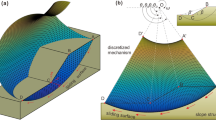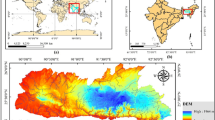Abstract
In the literature, different sampling strategies (such as landslide area, seed cell, scarp, point) have been applied to landslide susceptibility mapping studies. Landslide sampling strategy should reflect the pre-failure conditions of failures. Hence, researchers tried to develop sampling methods to provide pre-failure conditions. The main purpose of this study was to modify the seed cell sampling strategy for landslide susceptibility evaluations. Furthermore, landslide susceptibility maps were produced using two different sampling strategies (seed cell and landslide area), and compared in terms of their results. In accordance with these purposes, the eastern part of the Gallipoli Peninsula (Canakkale, Turkey) was selected as the study area in which to apply these two sampling strategies. For the seed cell sampling strategy, different random samplings were prepared by considering different buffer distances and different spatial resolutions. Sensitivity analyses were carried out using the landslide area (with depletion and accumulation zones) and samples and seed cells were acquired from different buffer zones with respect to different resolutions. The spatial performance of the landslide susceptibility maps of both sampling strategies were evaluated using area under the ROC curve (AUC) values. The resulting AUC results obtained from different random samplings and different spatial resolutions indicated that the appropriate buffer distance used to produce seed cells for the evaluation of landslide susceptibility maps in medium scale should be approximately 50 m.









Similar content being viewed by others
References
Akgun A (2012) A comparison of landslide susceptibility maps produced by logistic regression, multi-criteria decision, and likelihood ratio methods: a case study at İzmir. Turkey. Landslides 9(1):93–106
Akgun A, Sezer EA, Nefeslioglu HA, Gokceoglu C, Pradhan B (2012) An easy-to-use MATLAB program (MamLand) for the assessment of landslide susceptibility using a Mamdani fuzzy algorithm. Computer Geosci 38(1):23–34
Althuwaynee OF, Pradhan B, Park HJ, Lee JH (2014) A novel ensemble bivariate statistical evidential belief function with knowledge-based analytical hierarchy process and multivariate statistical logistic regression for landslide susceptibility mapping. Catena 114:21–36
Atkinson PM, Massari R (2011) Autologistic modelling of susceptibility to landsliding in the Central Apennines. Italy. Geomorphol 130(1–2):55–64
Bai SB, Wang J, Lu GN, Zhou PG, Hou SS, Xu SN (2010) GIS-based logistic regression for landslide susceptibility mapping of the Zhongxian segment in the three Gorges area, China. Geomorphology 115:23–31
Begueria S (2006) Validation and evaluation of predictive models in hazard assessment and risk management. Nat Hazards 37:315–329
Bui DT, Lofman O, Revhaug I, Dick O (2011) Landslide susceptibility analysis in the Hoa Binh province of Vietnam using statistical index and logistic regression. Nat Hazards 59(3):1413–1444
Carrara A, Crosta G, Frattini P (2008) Comparing models of debris–flow susceptibility in the alpine environment. Geomorphology 94(3–4):353–378
Chauhan S, Sharma M, Arora MK, Gupta NK (2010) Landslide susceptibility zonation through ratings derived from artificial neural network. Int J Appl Earth Obs Geoinf 12(5):340–350
Choi J, Oh H-J, Lee H-J, Lee C, Lee S (2012) Combining landslide susceptibility maps obtained from frequency ratio, logistic regression, and artificial neural network models using ASTER images and GIS. Eng Geol 124:12–23
Clerici A, Perego S, Tellini C, Vescovi P (2006) A GIS-based automated procedure for landslide susceptibility mapping by the conditional analysis method: the Baganza valley case study (Italian Northern Apennines). Environ Geol 50:941–961
CNN (2014) Cable News Network. http://edition.cnn.com
CORINE (2006) Coordinate of Information on the Environment. http://aris.ormansu.gov.tr/crn
Corominas J, Van Westen C, Frattini P, Cascini L, Malet JP, Fotopoulou S, Catani F, Van DenEeckhaut M, Mavrouli O, Agliardi F, Pitilakis K, Winter MG, Pastor M, Ferlisi S, Tofani V, Herva´s J, Smith JT (2014) Recommendations for the quantitative analysis of landslide risk. Bull Eng Geol Environ 73:209–263
Cruden DM, Varnes DJ (1996) Investigation and mitigation. In: Turner KA, Schuster RL (eds) Landslides: investigation and mitigation. Transportation Research Board, National Research Council, National Academy Press, Special Report 247, pp 36–75
Dagdelenler G (2013) Assessment of sampling and validation strategies in production of landslide susceptibility maps (Eastern Part of Gallipoli Peninsula). Hacettepe University, Institute of Science, Ankara, Turkey, p 186 (unpublished report)
Duman T, Nefeslioglu HA, Can T, Ates S, Durmaz S, Olgun S, Hamzacebi S, Kecer M (2006) Turkiye Heyelan Envanteri Haritasi, 1/500,000 olcekli Istanbul Paftasi. Maden Tetkik ve Arama Genel Mudurlugu (MTA) Ozel Yayinlar Serisi-6, Ankara, 25 s. (In Turkish)
Ercanoglu M, Temiz FA (2011) Application of logistic regression and fuzzy operators to landslide susceptibility assessment in Azdavay (Kastamonu, Turkey). Environ Earth Sci 64:949–964
Fawcett T (2006) An introduction to ROC analysis. Pattern Recogn Lett 27:861–874
Fell R, Corominas J, Bonnard C, Cascini L, Leroi E, Savage WZ (2008) Guidelines for landslide susceptibility, hazard and risk zoning for land use planning. Eng Geol 102:85–98
Gorum T, Gonencgil B, Gokceoglu C, Nefeslioglu HA (2008) Implementation of reconstructed geomorphologic units in landslide susceptibility mapping: the Melen Gorge (NW Turkey). Nat Hazards 46:323–351
Lee S, Talib JA (2005) Probabilistic landslide susceptibility and factor effect analysis. Environ Geol 47:982–990
MGM (2007) Meteoroloji Genel Mudurlugu (Turkish State Meteorological Service). http://www.mgm.gov.tr
Moore ID, Burch GJ (1986) Sediment transport capacity of sheet and rill flow: application of unit stream power theory. Water Resour Res 22:1350–1360
Moore ID, Wilson JP (1992) Length-slope factors for the revised universal soil loss equation: simplified method of estimation. J Soil Water Conserv 47(5):423–428
Moore ID, Grayson RB, Ladson AR (1991) Digital terrain modelling: a review of hydrological, geomorphological, and biological applications. Hydrol Process 5(1):3–30
MTA (2008) Sayısallastırılmıs 1/25000 Olcekli Jeoloji Haritası, H-16 Gelibolu paftası
Nandi A, Shakoor A (2010) A GIS-based landslide susceptibility evaluation using bivariate and multivariate statistical analyses. Eng Geol 110(1–2):11–20
Nefeslioglu HA, Gokceoglu C, Sonmez H (2008) An assessment on the use of logistic regression and artificial neural networks with different sampling strategies for the preparation of landslide susceptibility maps. Eng Geol 97(3–4):171–191
Nefeslioglu HA, Gokceoglu C, Sonmez H, Gorum T (2011) Medium-scale hazard mapping for shallow landslide initiation: the Buyukkoy catchment area (Cayeli, Rize, Turkey). Landslides 8(4):459–483
Nefeslioglu HA, San BT, Gokceoglu C, Duman TY (2012) An assessment on the use of Terra ASTER L3A data in landslide susceptibility mapping. Int J Appl Earth Obs Geoinf 14(1):40–60
Oh HJ, Pradhan B (2011) Application of a neuro-fuzzy model to landslide susceptibility mapping for shallow landslides in a tropical hilly area. Computer Geosci 37(9):1264–1276
Onal M (1986) Gelibolu Yarımadası orta bolumunun sedimanter fasiyesleri ve tektonik evrimi. KB Anadolu, Turkiye: Jeoloji Muh. 29:37–46
Ozdemir A, Altural T (2013) A comparative study of frequency ratio, weights of evidence and logistic regression methods for landslide susceptibility mapping: sultan Mountains, SW Turkey. J Asian Earth Sci 64:180–197
Pradhan B (2010) Landslide susceptibility mapping of a catchment area using frequency ratio, fuzzy logic and multivariate logistic regression approaches. J Indian Soc of Remote Sens 38(2):301–320
Pradhan B (2013) A comparative study on the predictive ability of the decision tree, support vector machine and neuro-fuzzy models in landslide susceptibility mapping using GIS. Comput Geosci 51:350–365
Pradhan B, Lee S (2010a) Regional landslide susceptibility analysis using back-propagation neural network model at Cameron Highland. Malays. Landslides 7(1):13–30
Pradhan B, Lee S (2010b) Landslide susceptibility assessment and factor effect analysis: backpropagation artificial neural networks and their comparison with frequency ratio and bivariate logistic regression modeling. Environ Modell Softw 25:747–759
Ramani SE, Pitchaimani K, Gnanamanickam VR (2011) GIS based landslide susceptibility mapping of Tevankarai Ar sub-watershed, Kodaikkanal, India using binary logistic regression analysis. J Mt Sci 8(4):505–551
San BT (2014) An evaluation of SVM using polygon-based random sampling in landslide susceptibility mapping: the Candir catchment area (Western Antalya, Turkey). Int J Appl Earth Obs Geoinf 26:399–412
Saroglu F, Emre O, Boray A (1987) Turkiye’nin diri fayları ve depremselligi. MTA, Rapor No: 8174
Shahabi H, Khezri S, Ahmada BB, Hashim M (2014) Landslide susceptibility mapping at central Zab basin, Iran: a comparison between analytical hierarchy process, frequency ratio and logistic regression models. Catena 115:55–70
Suzen ML, Doyuran V (2004) Data driven bivariate landslide susceptibility assessment using geographical information systems: a method and application to Asarsuyu catchment, Turkey. Eng Geol 71:303–321
TUAA (2013) Turkiye Ulusal Afet Arsiv (National Disaster Data Bank of Turkey). http://www.tuaa.afad.gov.tr
Wang L-J, Sawada K, Moriguchi S (2013) Landslide susceptibility analysis with logistic regression model based on FCM sampling strategy. Comput Geosci 57:81–92
Wilson JP, Gallant JC (2000) Terrain analysis principles and applications. Wiley, Toronto
Xu C, Dai F, Xu X, Lee YH (2012) GIS-based support vector machine modeling of earthquake-triggered landslide susceptibility in the Jianjiang River watershed, China. Geomorphol 145–146:70–80
Yalcin A, Reis S, Aydinoglu AC, Yomralioglu T (2011) A GIS-based comparative study of frequency ratio, analytical hierarchy process, bivariate statistics and logistics regression methods for landslide susceptibility mapping in Trabzon, NE Turkey. Catena 85:274–287
Yilmaz I (2009) Landslide susceptibility mapping using frequency ratio, logistic regression, artificial neural networks and their comparison: a case study from Kat landslides (Tokat-Turkey). Comput Geosci 35(6):1125–1138
Yilmaz I (2010) Comparison of landslide susceptibility mapping methodologies for Koyulhisar, Turkey: conditional probability, logistic regression, artificial neural networks, and support vector machine. Environ Earth Sci 61(4):821–836
Acknowledgments
The authors would like to thank two anonymous reviewers for their constructive comments and valuable contributions, which improved the scientific quality of the research.
Author information
Authors and Affiliations
Corresponding author
Rights and permissions
About this article
Cite this article
Dagdelenler, G., Nefeslioglu, H.A. & Gokceoglu, C. Modification of seed cell sampling strategy for landslide susceptibility mapping: an application from the Eastern part of the Gallipoli Peninsula (Canakkale, Turkey). Bull Eng Geol Environ 75, 575–590 (2016). https://doi.org/10.1007/s10064-015-0759-0
Received:
Accepted:
Published:
Issue Date:
DOI: https://doi.org/10.1007/s10064-015-0759-0




